高中英语语法专题复习教案大全(15个教案)
高中英语语法专题复习教案大全(15个教案)
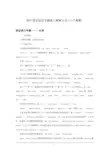
高中英语语法专题复习教案大全(15个教案)语法复习专题一——名词一、考点聚焦1.可数名词单、复数变化形式(1)规则变化。
①单数名词词尾直接加-s。
如:boy —boys, pen —pens。
②以s、x 、ch 、sh结尾的单词一般加-es。
如:glass —glasses,box—boxes, watch —watches, brush —brushes。
特例:stomach —stomachs。
③以“辅音字母+ y”结尾的变“y”为“i”再加“-es”。
如:baby —babies, lady —ladies, fly —flies。
④以“o”结尾的多数加-es。
如:tomato —tomatoes, potato —potatoes, hero —heroes。
但以两个元音字母结尾的名词和部分外来词中以o结尾的词只加-s。
如:radio —radios, zoo —zoos, photo —photos, piano —pianos, kilo —kilos, tobacco —tobaccos。
⑤以“f”或“fe”结尾的名词复数形式变“f”或“fe”为“v”,之后再加-es。
如:wife —wives, life —lives, knife —knives, wolf—wolves, self —selves, leaf —leaves等。
特例:handkerchief—handkerchiefs, roof —roofs, chief —chiefs, gulf —gulfs, belief —beliefs, cliff —cliffs。
⑥改变元音字母的。
如:man —men, mouse —mice, foot —feet,woman —women, tooth —teeth, goose —geese, ox —oxen。
特例:child —children。
⑦复合名词的复数形式。
高三英语复习教案(15篇)
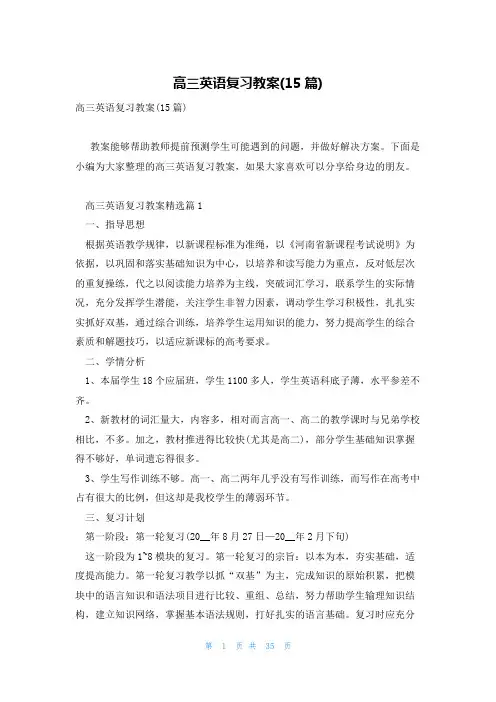
高三英语复习教案(15篇)高三英语复习教案(15篇)教案能够帮助教师提前预测学生可能遇到的问题,并做好解决方案。
下面是小编为大家整理的高三英语复习教案,如果大家喜欢可以分享给身边的朋友。
高三英语复习教案精选篇1一、指导思想根据英语教学规律,以新课程标准为准绳,以《河南省新课程考试说明》为依据,以巩固和落实基础知识为中心,以培养和读写能力为重点,反对低层次的重复操练,代之以阅读能力培养为主线,突破词汇学习,联系学生的实际情况,充分发挥学生潜能,关注学生非智力因素,调动学生学习积极性,扎扎实实抓好双基,通过综合训练,培养学生运用知识的能力,努力提高学生的综合素质和解题技巧,以适应新课标的高考要求。
二、学情分析1、本届学生18个应届班,学生1100多人,学生英语科底子薄,水平参差不齐。
2、新教材的词汇量大,内容多,相对而言高一、高二的教学课时与兄弟学校相比,不多。
加之,教材推进得比较快(尤其是高二),部分学生基础知识掌握得不够好,单词遗忘得很多。
3、学生写作训练不够。
高一、高二两年几乎没有写作训练,而写作在高考中占有很大的比例,但这却是我校学生的薄弱环节。
三、复习计划第一阶段:第一轮复习(20__年8月27日—20__年2月下旬)这一阶段为1~8模块的复习。
第一轮复习的宗旨:以本为本,夯实基础,适度提高能力。
第一轮复习教学以抓“双基”为主,完成知识的原始积累,把模块中的语言知识和语法项目进行比较、重组、总结,努力帮助学生输理知识结构,建立知识网络,掌握基本语法规则,打好扎实的语言基础。
复习时应充分发挥学生的主体作用。
精选一轮复习资料,一单元一案,每单元4x5课时,每周一次拓展练习。
注重阅读训练,2—3篇/日;强化书面表达训练,1篇/周(25分钟左右);书面表达常用的词、短语、句子记录背诵。
每天有一定量的词汇要求学生记忆,保证学生早、晚每次10分钟,重复记忆(要背诵的词、短语、句子列在平时的练习中)。
计划至20__年2月下旬结束第一轮复习。
高三英语语法复习教案[15章]
![高三英语语法复习教案[15章]](https://uimg.taocdn.com/60f356ffaeaad1f346933f34.webp)
高三年级英语语法专题复习教案集(全文共十五章)语法复习专题(1)Unit1 冠词一、考点聚焦1.不用冠词的情况(1)专有名词、物质名词、抽象名词、人名、地名等名词前,一般不加冠词。
China , America, SmithAir is matter.(2)可数名词前有物主代词、指示代词、名词所有格等限制时,不加冠词。
This dictionary is mine.(3)季节、月份、星期、节日、假日、一日三餐名称前一般不加冠词。
March, May Day, National D ay, Children’s Day, Women’s DayHave you had supper?Spring is the best season of the year.(4)称呼语或指家用雇用的nurse、cook等名词前及表示头衔职务的名词作宾语、补语及同位语时,一般不加冠词。
What’s this, Father? We made him our chairman.Ask nurse to put the child to bed. Professor Li.(5)学科名称、球类、棋类名称前不加冠词。
Do you study physics?He likes playing football/chess.(6)复数名词表示泛指一类人或事物时前不用冠词。
They are peasants/ workers.(7)在与by连用的交通工具名称前不加冠词。
by car, by bus,by bike, by train, by air/ water/ land但:take a bus, come in a boat, on the train/ bus需注意。
(8)某些固定词组中不用冠词。
①名词词组中:husband and wife, brother and sister, body and soul, day and night, knife and fork②介词词组中:to(at, from) school, in (to)class, in (to,at, from)university(college),to(in, into, from)church, to(in,into, out of)prison(hospital, bed), to(at, from, out of)work, to(in, from) town,at (from)home, to(at)sea, at night(noon, midnight), by car (bus, bicycle, plane), on foot注意:在有些词组中,有无冠词含义不同。
高考语法填空专题复习教案
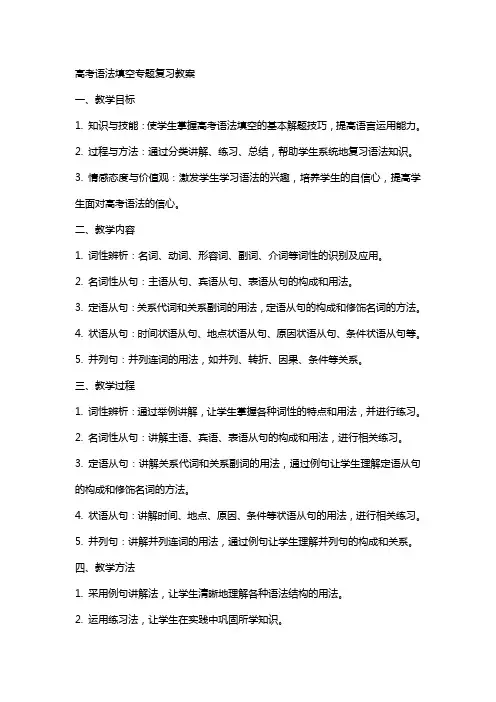
高考语法填空专题复习教案一、教学目标1. 知识与技能:使学生掌握高考语法填空的基本解题技巧,提高语言运用能力。
2. 过程与方法:通过分类讲解、练习、总结,帮助学生系统地复习语法知识。
3. 情感态度与价值观:激发学生学习语法的兴趣,培养学生的自信心,提高学生面对高考语法的信心。
二、教学内容1. 词性辨析:名词、动词、形容词、副词、介词等词性的识别及应用。
2. 名词性从句:主语从句、宾语从句、表语从句的构成和用法。
3. 定语从句:关系代词和关系副词的用法,定语从句的构成和修饰名词的方法。
4. 状语从句:时间状语从句、地点状语从句、原因状语从句、条件状语从句等。
5. 并列句:并列连词的用法,如并列、转折、因果、条件等关系。
三、教学过程1. 词性辨析:通过举例讲解,让学生掌握各种词性的特点和用法,并进行练习。
2. 名词性从句:讲解主语、宾语、表语从句的构成和用法,进行相关练习。
3. 定语从句:讲解关系代词和关系副词的用法,通过例句让学生理解定语从句的构成和修饰名词的方法。
4. 状语从句:讲解时间、地点、原因、条件等状语从句的用法,进行相关练习。
5. 并列句:讲解并列连词的用法,通过例句让学生理解并列句的构成和关系。
四、教学方法1. 采用例句讲解法,让学生清晰地理解各种语法结构的用法。
2. 运用练习法,让学生在实践中巩固所学知识。
3. 采用分组讨论法,培养学生的合作精神和沟通能力。
4. 运用归纳总结法,帮助学生梳理知识点,形成系统。
五、教学评价1. 课堂练习:观察学生在练习中的表现,评估其对语法知识的掌握程度。
2. 课后作业:布置相关作业,检查学生对课堂所学知识的巩固情况。
3. 阶段测试:进行阶段性的测试,评估学生的综合语言运用能力。
4. 学生反馈:鼓励学生提出问题,及时解答学生的疑惑,调整教学方法。
六、教学策略1. 针对不同学生的学习情况,制定个性化的复习计划,确保每个学生都能在复习过程中得到针对性的指导。
高中英语语法教案及配套练习
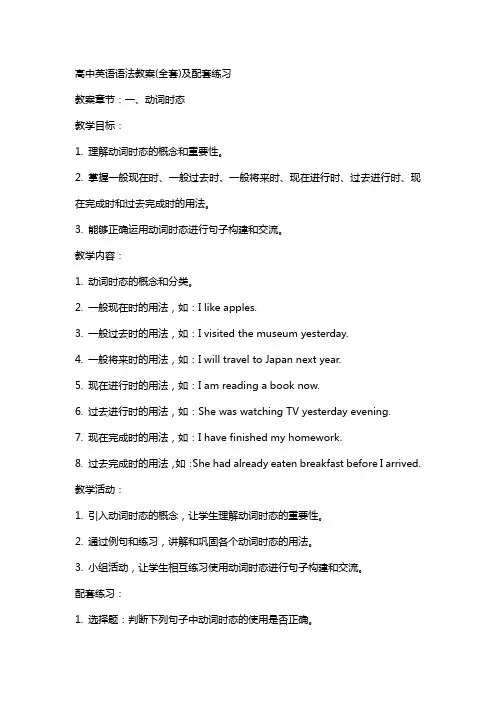
高中英语语法教案(全套)及配套练习教案章节:一、动词时态教学目标:1. 理解动词时态的概念和重要性。
2. 掌握一般现在时、一般过去时、一般将来时、现在进行时、过去进行时、现在完成时和过去完成时的用法。
3. 能够正确运用动词时态进行句子构建和交流。
教学内容:1. 动词时态的概念和分类。
2. 一般现在时的用法,如:I like apples.3. 一般过去时的用法,如:I visited the museum yesterday.4. 一般将来时的用法,如:I will travel to Japan next year.5. 现在进行时的用法,如:I am reading a book now.6. 过去进行时的用法,如:She was watching TV yesterday evening.7. 现在完成时的用法,如:I have finished my homework.8. 过去完成时的用法,如:She had already eaten breakfast before I arrived. 教学活动:1. 引入动词时态的概念,让学生理解动词时态的重要性。
2. 通过例句和练习,讲解和巩固各个动词时态的用法。
3. 小组活动,让学生相互练习使用动词时态进行句子构建和交流。
配套练习:1. 选择题:判断下列句子中动词时态的使用是否正确。
2. 填空题:根据语境,选择合适的动词时态填空。
3. 翻译题:将下列句子翻译成英文,注意使用正确的动词时态。
教案章节:二、名词和冠词教学目标:1. 理解名词的概念和重要性。
2. 掌握可数名词和不可数名词的用法。
3. 掌握定冠词和不定冠词的用法。
4. 能够正确运用名词和冠词进行句子构建和交流。
教学内容:1. 名词的概念和分类。
2. 可数名词和不可数名词的用法,如:apple (可数名词)和water (不可数名词)。
3. 定冠词和不定冠词的用法,如:The cat (定冠词)和a cat (不定冠词)。
高中英语语法教案
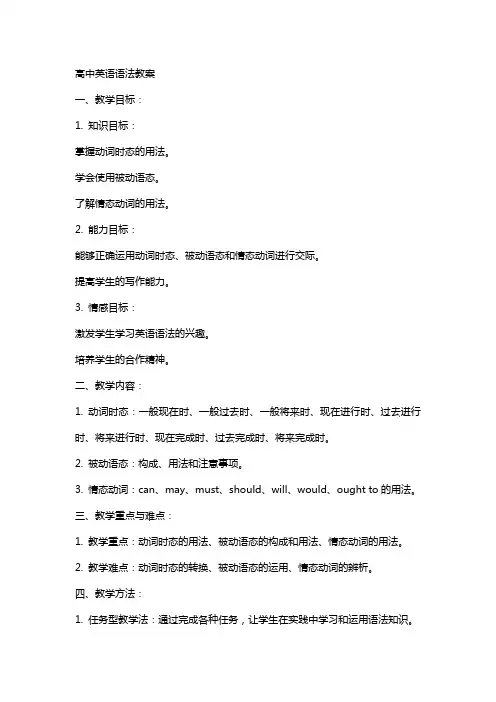
高中英语语法教案一、教学目标:1. 知识目标:掌握动词时态的用法。
学会使用被动语态。
了解情态动词的用法。
2. 能力目标:能够正确运用动词时态、被动语态和情态动词进行交际。
提高学生的写作能力。
3. 情感目标:激发学生学习英语语法的兴趣。
培养学生的合作精神。
二、教学内容:1. 动词时态:一般现在时、一般过去时、一般将来时、现在进行时、过去进行时、将来进行时、现在完成时、过去完成时、将来完成时。
2. 被动语态:构成、用法和注意事项。
3. 情态动词:can、may、must、should、will、would、ought to的用法。
三、教学重点与难点:1. 教学重点:动词时态的用法、被动语态的构成和用法、情态动词的用法。
2. 教学难点:动词时态的转换、被动语态的运用、情态动词的辨析。
四、教学方法:1. 任务型教学法:通过完成各种任务,让学生在实践中学习和运用语法知识。
2. 交际式教学法:通过情景模拟和角色扮演,让学生在真实的语境中运用语法知识。
3. 合作学习法:分组讨论和合作完成任务,培养学生的团队合作能力。
五、教学步骤:1. 引入:通过图片或故事引入本节课的主题,激发学生的兴趣。
2. 讲解:讲解动词时态、被动语态和情态动词的用法,示例说明。
3. 练习:设计各种练习题,让学生巩固所学知识。
4. 任务:布置任务,让学生在实际操作中运用所学语法知识。
6. 作业:布置作业,巩固所学知识。
7. 反馈:及时给予学生反馈,鼓励优秀,帮助进步。
8. 课后辅导:针对学生的不同需求,提供课后辅导。
9. 教学评价:定期进行语法测试,评估学生的学习效果。
10. 教学反思:不断反思和改进教学方法,提高教学质量。
六、教学资源:1. 教材:高中英语教材。
2. 辅助材料:动词时态、被动语态和情态动词的练习题、情景模拟剧本、多媒体课件。
3. 教学工具:投影仪、电脑、黑板、粉笔。
七、教学评价:1. 过程性评价:观察学生在课堂活动中的参与程度、任务完成情况和合作能力。
高中英语语法教案(全套)
高中英语语法教案(全套)高中英语语法教案(全套)及配套练习1、名词2、冠词和数词3、代词 4. 形容词和副词 5、动词6.动名词 7. 动词不定式 8.特殊词精讲9、分词 10.独立主格11. 动词的时态 12. 动词的语态13. 句子的种类14. 倒装15. 主谓一致16. 虚拟语气17. 名词性从句 18. 定语从句 19. 状语从句20. 连词21. 情态动词名词可以分为专有名词和普通名词,专有名词是某个(些)人,地方,机构等专有的名称,如Beijing,China等。
普通名词是一类人或东西或是一个抽象概念的名词,如:book,sadness等。
普通名词又可分为下面四类:1)个体名词:表示某类人或东西中的个体,如:gun。
2)集体名词:表示若干个个体组成的集合体,如:family。
3)物质名词:表示无法分为个体的实物,如:air。
4)抽象名词:表示动作、状态、品质、感情等抽象概念,如:work。
个体名词和集体名词可以用数目来计算,称为可数名词,物质名词和抽象名词一般无法用数目计算,称为不可数名词。
归纳一下,名词的分类可以下图表示:名词专有名词不可数名词普通名词物质名词抽象名词集体名词可数名词个体名词情况构成方法读音例词一般情况加 -s 清辅音后读/s/ map-maps浊辅音和元音后读 /z/ bag-bags /car-cars以s, sh, ch, x等结尾加 -es 读 /iz/ bus-buses/ watch-watches 以ce, se, ze,等结尾加 -s 读 /iz/ license-licenses以辅音字母+y结尾变y 为i再加es 读 /z/ baby---babies1)以y结尾的专有名词,或元音字母+y 结尾的名词变复数时,直接加s变复数。
如:two Marys the Henrysmonkey---monkeys holiday---holidays2)以o 结尾的名词,变复数时:a. 加s,如: photo---photos piano---pianosradio---radios zoo---zoos;b. 加es,如:potato--potatoes tomato--tomatoesc. 上述a和b两种方法均可,如zero---zeros / zeroes。
高中英语语法教案(15篇)_1
高中英语语法教案(15篇)高中英语语法教案(篇3)高中英语语法教案(篇4)高中英语语法教案(篇5)高中英语语法教案(篇6)教学目标Wordsbase, command, request, recognizeExpressionsbecause of, come up, at present, make use of, such as, play a part (in)Patterns…because of that, English began to b spoken in many other countries.Actually all languages change and develop…The latter gave a separate identity to American English spelling.教学重难点■To help students get to know about English development■ To help students better understand “learning English”■To help students understand and use some important words and expressions■ To help students identify examples of Indirect Speech (II): request commands in the text 教学工具课件教学过程⑴Warming up by listingGood morning, class. We have been learning English for several years. But how many English-speaking countries are there in the world? Now let’s make a list of them on the blackboard.English Countries ExplanationMother tongue the United Kingdomthe United States of AmericaCanadaAustraliaSouth AfricaIrelandNew Zealand The people in these countries are native speakers of English. In total, for more than 375 million people English is their mother tongue.Second language IndiaPakistanNigeriathe Philippines These people speak the language of their own country at home but the language of the government, schools, newspapers, and TV is English. Foreign language ChinaGermanyFranceetc. The number of people who learn English as a foreign language is more than 750 million.⑵Warming up by answering questions about English Good morning, class. Today we shall start learning Unit 2 English around the world. But how much do you know about English?●What is Standard English?Standard English is the form of English that most people in Britain use, and that is not limited to one area or group of people.●What is a dialect?A dialect is a variety of a language spoken only in one area, in which words, or grammar are slightlydifferent from other forms of the same language.●Do we have standard Chinese? What is it?In China there’re so many dialects that the government encourages the whole nation to speak Putonghua, which is regarded as standard Chinese.⑶Warming up by giving reasonsUnit 2 English around the world is what we are going to learn today. We are all learning English now because English is so popular in the world. But do you know why it is so? How many reasons could you giving for the spread of English around the world?English is one of the official languages of the Olympic Games and the United Nations.English dominates international websites and provides nearly all of the new computer terminology. Tourism and trade from Western Europe and North America has contributed to the spread of English.Satellite TV, radio programs like Joy FM, CDs and, of course, Hollywood films all broadcast English into China. Also, a number of Chinese films include English subtitles.2.Pre-readingWe are learning English here. But why are we learning it? Could you suggest to the class as many reasons as you can think of, why people in the world learn English?for work, as a hobby, to learn about other people, to travel, to read literature in the original, to read research papers, to meet foreigners, to surf the Internet, to pass exams, etc.Go on with your reasons. I shall write your suggestions on the board as you make them.3. Skimming the text for general ideasNow we go to page 9 to skim the text for the main idea of each paragraph.Paragraph 1: The spread of the English language in the worldParagraph 2: Native speaker can understand each other even if they don’t speak the same kind of English. Paragraph 3: English changes and develops when cultures meet and communicate with each other.Paragraph 4: By the 19th century English is settled. Paragraph 5: English is spoken as a foreign language or second language in South Asia.4. Reading and fillingRead the text to complete the chart below.Time English is influenced by…AD 450-1150 German1150-1500 FrenchIn the 1600’s Shakespeare, who make use of a wider vocabulary than ever beforeBy the 19th century Samuel Johnson, Noah Webster Now Languages in South Asia, in Singapore, in Malaysia, in Africa and in China5. Reading and copyingNext we shall go over the text once more. This time try find and copy all the useful expressions down in your notebook.Useful expressionsat the end of…, make voyages, speak English as…, in the next century, change over time, communicate with…, be based on…, at present, become less like…, rule England, enrich the English language, make use of…, move to…, later in the 18th century, give a separate identity to…, have a very large number of…, fluent English speakers, become the language for…,develop one’s own identity, increase rapidly.高中英语语法教案(篇7)高中英语阅读课文具有题材广泛、体裁各样、语言学问丰富等特征,是各单元教学的核心部分,也是培育同学阅读力量的主要渠道。
高中英语语法教案
高中英语语法教案一、前言1. 教学目标:通过本章的学习,使学生掌握英语语法的基本概念和用法,提高学生的英语写作和口语表达能力。
2. 教学内容:本章主要介绍英语语法的基本要素,包括名词、动词、形容词、副词和介词等。
二、名词1. 教学目标:使学生掌握名词的分类、用法和修饰语的搭配。
2. 教学内容:(1) 名词的分类:可数名词、不可数名词和集合名词。
(2) 名词的用法:名词作主语、宾语、表语等。
(3) 名词的修饰语:形容词、副词和介词短语等。
三、动词1. 教学目标:使学生掌握动词的分类、时态和语态。
2. 教学内容:(1) 动词的分类:行为动词、助动词和情态动词。
(2) 动词的时态:一般现在时、一般过去时、一般将来时等。
(3) 动词的语态:主动语态和被动语态。
四、形容词和副词1. 教学目标:使学生掌握形容词和副词的比较级和最高级,以及它们的用法。
2. 教学内容:(1) 形容词和副词的比较级:规则变化和不规则变化。
(2) 形容词和副词的最高级:规则变化和不规则变化。
(3) 形容词和副词的用法:形容词作定语、表语、补语等;副词作状语、补语等。
五、介词1. 教学目标:使学生掌握常见介词的用法和搭配。
2. 教学内容:(1) 介词的分类:方位介词、时间介词、原因介词等。
(2) 介词的用法:介词+名词/代词作宾语、介词+动词不定式等。
(3) 介词的搭配:介词与名词、动词、形容词等搭配使用的常见短语。
六、连词1. 教学目标:使学生掌握常见连词的用法,包括并列连词和从属连词,以及它们在句子中的作用。
2. 教学内容:(1) 并列连词:and, but, or, nor, for, yet, so等。
(2) 从属连词:because, although, if, since, when, where, who, that等。
(3) 连词在句子中的作用:连接单词、短语或句子,构成复杂句子结构。
七、冠词1. 教学目标:使学生掌握不定冠词和定冠词的用法,以及它们的区别。
高三英语复习教案大全
高三英语复习教案大全高三英语复习教案大全(篇1)一、课程类型:高三复习课二、教学目标:一) 认知目标1.句型和语言点(见教学重点)。
2.用所学的知识与伙伴进行交流、沟通,学会改错、写作。
二)情感目标利用多媒体手段营造积极和谐教学氛围,使学生不自觉地进入情景之中,充分调动学生的思维活动和情感体验,引起学生的共鸣。
三)智力目标在运用语言的过程中培养学生的观察力、分析力、想象力和自学能力,帮助学生加强记忆力,提高思维能力和运用英语的综合能力,激发创造能力。
三、教材分析:这是高三复习阶段的一节写作课。
这节书面表达课就从审题谋篇等方面入手来完成教学目的,侧重于引导学生在把握书面表达的写作前准备即谋篇审题能力,使学生在动手写作前迅速构思按照规范的模式来完成谋篇审题:在教学中不仅仅强调写,对于与写作紧密联系的听、说、读、改错都有兼顾。
采用任务型教学法和小组合作探究学习法,从而激发学生的学习兴趣,同时也能扩大课堂的语料输入量及学生的语言输出量。
四、教学重点:1. 学会审题和谋篇2. 掌握多样化的表达方式3. 熟练各段中的固定写作套路五、教学难点:1. 如何帮助学生运用写作策略,促进学生自主写作。
2. 使学生了解谋篇的重要性,培养谋篇的能力和习惯。
六、教学方法:1、活动教学法:2、任务型教学法:七、教学设计:Step 1. Warming upCome up with some proverbs for the students to put them into Chinese.Recitation is of the first importance in any language learning!Practice makes perfect! …What do you learn from the above proverbs?Step 2. PresentationMake it clear to the students the importance of writing in Englishsubject of the college entrance exams and then the goals of this lesson.Step 3. ExhibitionShow on the whiteboard a writing.高三英语复习教案大全(篇2)一、教学设计意图在《高中英语新课程标准》中讲到“高中英语课程要有利于学生优化英语学习方式,使他们通过观察、体验、探究等积极主动的学习方法,充分发挥自己的学习潜能,形成有效的学习策略,提高自主学习的能力;要有利于学生学会运用多种媒体和信息源,拓宽学习渠道并形成具有个性的学习方法和风格。
- 1、下载文档前请自行甄别文档内容的完整性,平台不提供额外的编辑、内容补充、找答案等附加服务。
- 2、"仅部分预览"的文档,不可在线预览部分如存在完整性等问题,可反馈申请退款(可完整预览的文档不适用该条件!)。
- 3、如文档侵犯您的权益,请联系客服反馈,我们会尽快为您处理(人工客服工作时间:9:00-18:30)。
高中英语语法专题复习教案大全(15个教案)语法复习专题一——名词一、考点聚焦1.可数名词单、复数变化形式(1)规则变化。
①单数名词词尾直接加-s。
如:boy —boys, pen —pens。
②以s、x 、ch 、sh结尾的单词一般加-es。
如:glass —glasses,box—boxes, watch —watches, brush —brushes。
特例:stomach —stomachs。
③以“辅音字母+ y”结尾的变“y”为“i”再加“-es”。
如:baby —babies, lady —ladies, fly —flies。
④以“o”结尾的多数加-es。
如:tomato —tomatoes, potato —potatoes, hero —heroes。
但以两个元音字母结尾的名词和部分外来词中以o结尾的词只加-s。
如:radio —radios, zoo —zoos, photo —photos, piano —pianos, kilo —kilos, tobacco —tobaccos。
⑤以“f”或“fe”结尾的名词复数形式变“f”或“fe”为“v”,之后再加-es。
如:wife —wives, life —lives, knife —knives, wolf—wolves, self —selves, leaf —leaves等。
特例:handkerchief—handkerchiefs, roof —roofs, chief —chiefs, gulf —gulfs, belief —beliefs, cliff —cliffs。
⑥改变元音字母的。
如:man —men, mouse —mice, foot —feet,woman —women, tooth —teeth, goose —geese, ox —oxen。
特例:child —children。
⑦复合名词的复数形式。
(A)在复合词中最后名词尾加-s。
如:armchair —armchairs, bookcase —bookcases, bookstore —bookstores。
(B)man和woman作定语修饰另一个名词时,前后两个名词都要变成复数。
如:man doctor —men doctors, woman driver —women drivers。
(C)与介词或副词一起构成的复合名词应在主体名词部分加-s。
如:brother-in-law —brothers-in-law, passer-by —passers-by。
⑧有的名词有两种复数形式。
如:zero —zeros 、zeroes, deer —deers 、deer。
penny的两种复数形式含义有所不同。
如:pence(便士的钱数),pennies(便士的枚数)。
(2)不规则变化。
①单、复数同形。
如:means, aircraft, deer, fish, Chinese,Japanese, sheep, works(工厂),cattle。
②合成名词的复数。
如:boy-friend —boy-friends, go-between—go-betweens(中间人),grown-up —grown-ups。
③有些名词通常只用作复数。
如:glasses眼镜,clothes衣服,goods货物,trousers裤子,belongings所有物,wages工资,riches财富, surroundings环境,ashes 灰尘, compasses圆规,cattle家畜,congratulations祝贺,have words with sb. 同某人吵架,in high spirits以很高热情地,give one’s regards to sb.向某人问侯,in rags衣衫破烂,It is good manners to do sth.有礼貌做某事。
④集体名词的数。
有些集体名词通常只用作复数,如:people,cattle, police; 有些名词只用作单数,如:machinery, furniture, mankind, jewellery;有些名词既可用作单数又可用作复数,单数看做整体,复数看做集体的各个成员。
如:The crew is large.船员人数很多(指整体);The crew are all tired.船员们都累坏了(个体)。
2、不可数名词的数(1)一般说来抽象名词为不可数名词,但当抽象名词表示具体的东西时,可用作可数名词且词义发生变化,主要类型如下:①抽象名词表示具有某种特性、状态、感情情绪的人或事。
如:抽象名词(不可数)具体化(个体名词,可数名词)in surprise惊讶地 a surprise一件令人惊讶的事win success获得成功 a success一个(件)成功的人(事)win honor赢得荣誉an honor一个(件)引以为荣的(事)Failure(失败)is the mother of success a failure失败者失败是成功之母。
by experience靠经验an experience一次经历youth青春 a youth一个青年人have pity on sb.怜悯某人 a pity可惜的事情with pleasure乐意 a pleasure乐事②抽象名词与a(an)连用,淡化了抽象概念,转化为似乎可以体验到的动作、行为或类别。
如:A knowledge of English is a must in international trade.Would you like to have a walk (swim, bath, talk) with me?It is waste of time reading such a novel.She made an apology to her mother for her wrong doings.(2)物质名词是不可数名词,但表示数量或种类之多时,可以用作可数名词。
如:①物质名词有形或数的相应物体,有单、复数。
如:some coffee一些咖啡,a coffee一杯咖啡,three coffees三杯咖啡,some drink一些饮料, a drink一杯饮料,three drinks三杯饮料,his hair他的头发,a few grey hairs几根白发,glass玻璃,a glass一只玻璃杯。
②物质名词有前置后置修饰时,前面要使用不定冠词。
have breakfast The road is covered with snow.have a wonderful breakfast They have a heavy snow every year.Time and tide wait for no man.We had a wonderful time last night.(3)有复数形式的不可数名词①有些抽象名词往往以复数形式出现,起到一种丰富语言感情色彩或强调某种特殊状态的作用。
如:Use your brains, please.They have smoothed away the difficulties.Have you made preparations for tomorrow’s meeting?Many thanks for your kindness.No pains, no gains.After many failures, they finally succeeded.②有些物质名词以复数形式出现,表示数量之多,范围之广。
如:The boy burst into tears at the bad news.The rising waters did a lot of harm to the crops.The stone bridge broke down in heavy rains.3.名词所有格(1)“’s”所有格的特殊表示形式有:①用于表示时间、距离、价格、重量等的名词后,如:today’snewspaper, five minutes’walk(drive),five pounds’ weight, ten dollars’ worth of coffee。
②用于表示国家、世界、城市等地方的名词后。
如:the earth’s planet, the word’s population, China’s industry, New York’s parks。
(2)“of”所有格的特殊表示方式有:①表示“部分”时,一般在所修饰的名词前有一个表示数量的词(a、two、several、some、no、many等),如:Some students of Mister Zhang’s have gone to college.张老师的一些学生已经上大学了。
②表示“其中之一,其中一部分”的意思时,用:a friend of Tom’s汤姆的一个朋友(许多朋友中的一位)。
③表示赞扬、批评或厌恶等感情色彩时,应该用:that/this/these/those + 名词(单、复数)of Mary’s/yours/his/hers。
如:That invention of hers belongs to the world. 她的那项发明是属于全世界的(表赞赏)。
4、名词作定语英语中有些名词没有其对应的同根形容词,这些名词可以直接用来作定语修饰另一个名词。
(1)分类意义。
air pollution 空气污染boy friend 男朋友coffee cup咖啡杯income tax所得税tennis ball网球song writer歌曲作家body language身体语言road accident交通事故Nobel Prize诺贝尔奖(2)时间、地点、称呼等。
Doctor Jack杰克医生Professor Li李教授evening school夜校winter sleep冬眠street dance 街舞country music乡村音乐village people村民school education学校教育China problem中国问题(3)表目的、手段、来源,所属意义。
reception desk接待台sports field田径场stone table石桌color TV彩电weather report天气预报二、精典名题导解选择填空1. It is generally believed that teaching is ___________it is a science. (NMET 2001)A. an art much asB. much an art asC. as an art much asD. as much an art as解析:答案为D。
